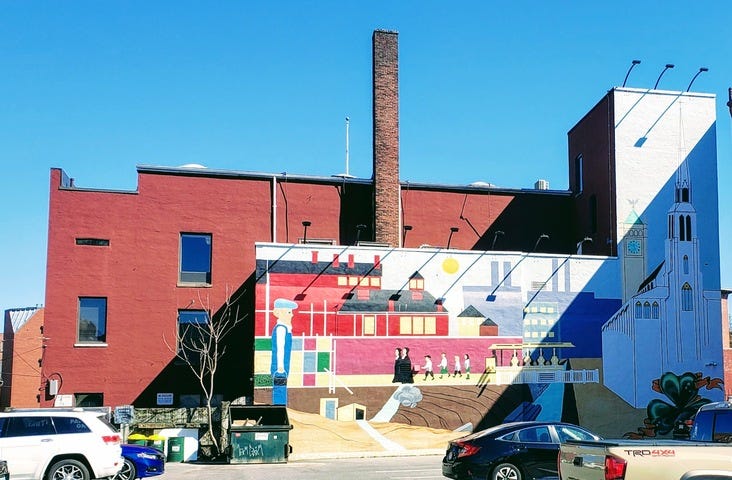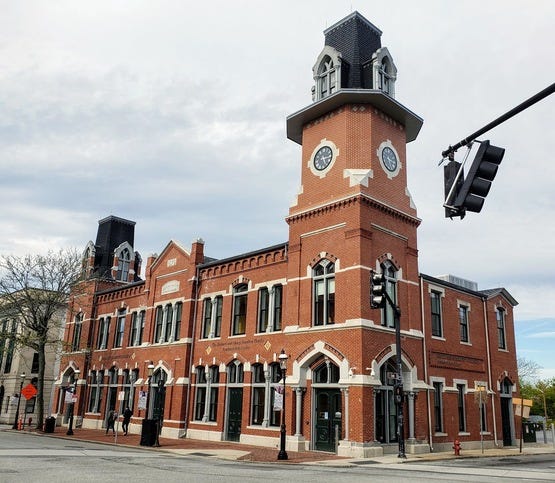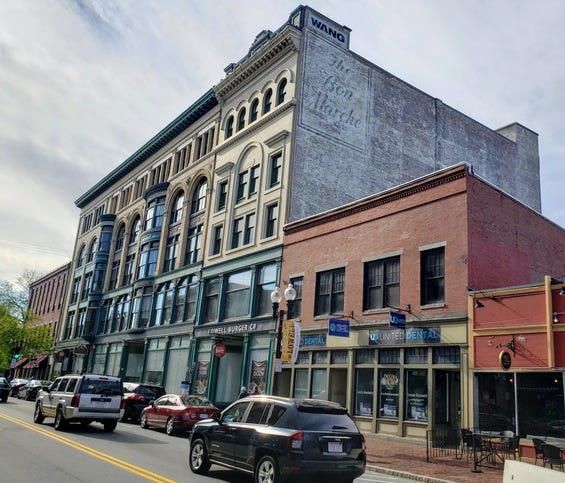After having visited many milltowns I am finally checking out the grandaddy of them all, the quintessential cradle of the Industrial Revolution, Lowell MA.

Main purpose of visiting was to check out the Western Avenue Studios Art Market and Open Studios. It formerly was the site of factories for upholstery for trains as well as cars. Now it is 143 studios home to 215 artists. Some might say it is the biggest collection of artists in one location east of the Mississippi River 😮

I did not reveal that I had just arrived here by ways of 20 mile bicycle ride. You can bet that I was hungry at this point.
Within the confines, there is food truck named the Empanada Dada. It was such a good deal, for $10 you could choose any five empanadas. Very authentic too, the owner himself is a son of Cuban immigrants

After these delicious empanadas , you might want to grab a coffee. Luckily there is Tiny Arms Coffee located on the 2nd floor of the Western Ave Studios. If you are wondering how they came up with that name? Its very random, the 2 founders were strolling in the streets of Brooklyn and admiring graffiti. They got inspired of one of a T-Rex that they decided to name their store by a particular feature of the creature. If you look at their packaging you will notice the character in all of their designs:

Alas this is not the only gathering place for artists, there is also Mill No 5 structure built in 1873. It was originally part of the Appleton Manufacturing Company. The mill was built for a new technology: steam power. This advance allowed mills to be built away from the canals. It thrived for a while but Appleton had to move production south in 1927, in the meantime building was leased to the Suffolk Knitting Company and other tenants. Today it is a hip space replete with boutique movie theater, yoga studio, restaurants and shops.

If you were to wander today you will find such things as the Coffee and Cotton a cozy eclectic café with a creative menu. Throughout the space you will encounter artwork by Eyeformation an artists local to the area with his studio inside the building. At the topmost floor there is Curation 250 gift store where you can purchase prints and shirts by the artist.

Across the street you’ll find the Lowell Community Health Center, it is result of the conversion of 100,000 sf of historic Hamilton Mill to healthcare space.

I take you now to see the pride of Lowell. Why did it become the industrial powerhouse that it was? It is all due to the power and flow from the Pawtucket Falls along the Merrimack River. The waterfall and rapids below it drop a total of 32 feet in a little under a mile. A dam was built to divert water at the top of the falls into the canal raceways running downstream through the town.

Back into town, the primary focal point is not other than its city hall, it is an imposing centerpiece of downtown. Not to be outflanked is the building immediately adjacent, Memorial Hall and public library. When it was built it was dedicated to the memory of the Lowell men who had lost their lives in the Civil War.

This leads me to the monument dedicated to two of the first Union casualties, Luther C. Ladd and Addison O. Whitney

Lowell also lays honor to the various nationalities that escaped strife to establish a new home in Lowell. That includes Laos, Cambodian and Armenians immigrants. Lowell in fact has become home to the second largest Cambodian community in the United States. Between 1975 and 1979 the Cambodian Genocide took place which was an explosion of mass violence that saw between 1.5 and 3 million people killed at the hands of the Khmer Rouge, a communist political group.

Before you leave the area be sure to check out Simply Khmer restaurant which serves authentic Cambodian dishes. I had the Cha-kroung chicken which was stir-fried ground chicken, onions, jalapeno peppers, red/green bell peppers and holy basil in kroeung herb paste

I then enter the oldest pub of Lowell, Worthen House Café. I didn’t go in to drink but to check out one of its main attractions: a pulley-driven fan system. Apparently its one of only four of its kind in the country. The bartenders are happy to turn it on for you if you ask them.

Another fun fact about Worthen House Café is that Edgar Allan Poe frequented the spot too, kind of evident in the raven embedded in the logo for the spot.
Right across the street from it we have a mural celebrating the Irish heritage in the area. They were one of the first immigrants to arrive in the 1830s after the Great Famine. They found labor working at the mills.

We then approach the next mill building, the Market Mills. It was built by the former Lowell Manufacturing Company

In front of one of the entrances is Homage to Women sculpture consisting of five intertwined figures serving as a tribute to Lowell’s 19th century mill girls. During the 1830s to 1850s they rallied and organized in order to challenge the terrible conditions and unfair pay they were receiving, at the time less than half the pay that their male counterparts would receive. It resulted in strikes in 1834 followed by another in 1836 and finally in 1845, the first women workers’ union was formed.

In the vicinity you will find a Boston & Maine Railroad Steam Locomotive put out just for display purposes. It used to deliver cars of raw materials from the railroad yard to local industries and to pick up loaded and empty cars to transport to other destinations.

Which brings us to the Boston and Maine Railroad Depot. It only served as a railroad station until 1895. It underwent many office uses and even at one point functioned as a theater. Today it has been turned into an arts center for Middlesex Community College.

2 murals really stick out at me. First is MCC’s Lowell Campus. Titled “DREAM, HUNT, MAKE”. This mural draws inspiration from the artist Fonki who is Cambodian born in France, his parents were refugees of the Khmer Rouge Genocide.

The next one is by the Dominican artist Evaristo Angurria, his murals always portray the figure of Dominican women wearing hair rollers which is a huge part of the culture. The building itself is a National Park Service recognised site for its role in the Underground Railroad. Mechanic’s Hall was originally built in 1835 by the Middlesex Mechanics Association as a meeting place and library for skilled craftsmen. It then became a site where an escaped slave from Virginia named Nathaniel Booth opened a barbershop on the first floor and thus became a hub for abolitionist activity.

Not that I needed to fill gas at the time but I thought the vintage sign looked really cool. Haffner’s Gasoline is a local chain that started in 1925 and operates locations in Massachusetts and New Hampshire.

As we walk downtown, come across many fantastic buildings. One in particular is the Bon Marché building — longtime anchor for retail business. It benefited from the business of the mill workers right after they earn their wages to spend on home goods. As industry shuttered same effect hit retail. It eventually sold off to Jordan Marsh remained in operation for a couple more years until completely shuttering. The same fate befalls the Jordan Marsh chain too, they eventually ceded to Macy’s department stores. Its just the reality of things, department stores are not killing it these days like they used to back in the days.

Right across the street from it you you see Page’s Clock. It was installed right outside a candy store that filled five floors. Not only did they sell candy but they offered ice cream, baked goods, they were a restaurant, a tea room, a soda fountain, catering and a delicatessen. They essentially did it all!!

Now approach another iconic structure the landmarked Sun Building built in 1914 to house the Lowell Sun newspaper operation. Today it serves as an elderly residential building.

You definitely do not run out of interesting buildings off Merrimack Street. I could only come up with the names of the buildings from left to right: Hildreth building; Union National Bank; Wyman’s Exchange Building



I start approaching a development right on the banks of a canal. What’s here is called the Massachusetts Mills. It was a major site for spinning cotton, today it has been turned into 182 apartments.



Adjacent to here is another complex called the Boott Cotton Mills. Today it houses both a museum and bunch of apartments.



The Wannalancit Mills (formerly the Suffolk Mills) parts of which date to the 1830s at the earliest. Its namesake is a corruption of Wonalancet, a sachem or sagamore of the Penacook Native American tribe. Today the complex is home to office space, conference center, and university research facilities.

Another mainstay of the era is the LawrenceManufacturing Company, established in 1831 by Boston merchants Abbott and Amos Lawrence. Produced hosiery, underwear, sheetings, drills, denims, and flannels. The brothers went on to develop the city of Lawrence, north on the Merrimack River, which was a carbon copy of Lowell.

I definitely did see a lot today, why not end it at high note? Decide to hit up Elliot’s Original Hot Dogs, family establishment owned since 1920 and cash-only.

Luckily I had $3 change to snag a chili and cheese dog 👌








